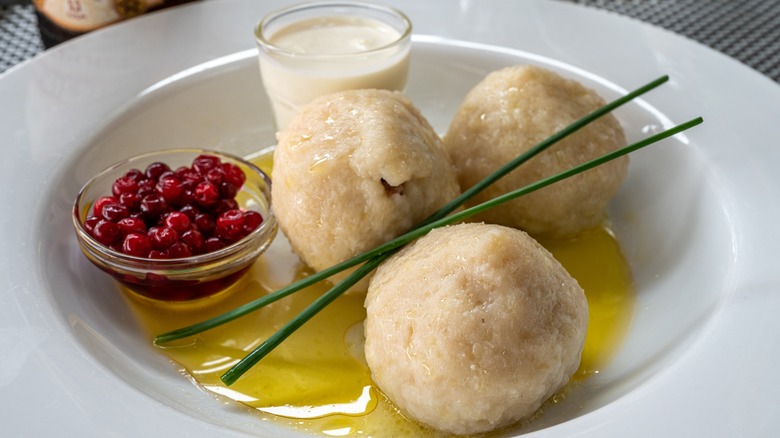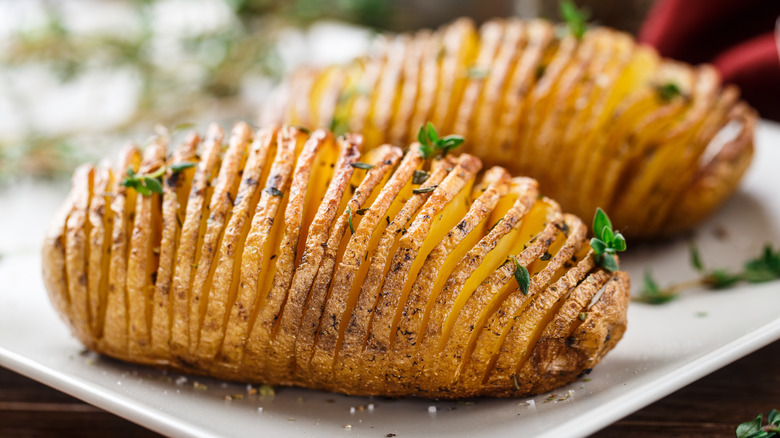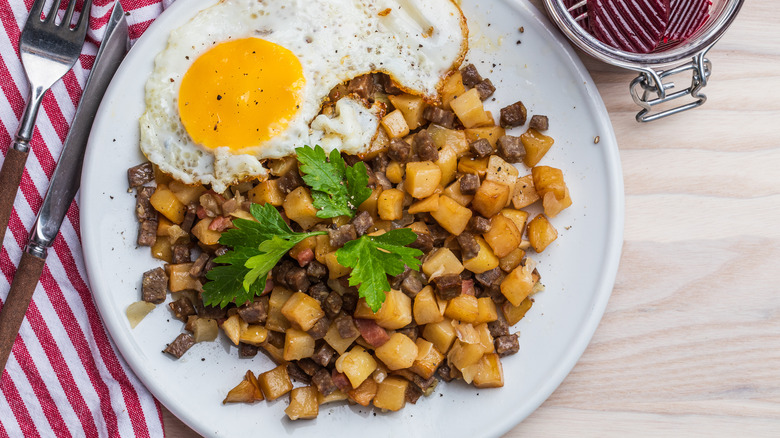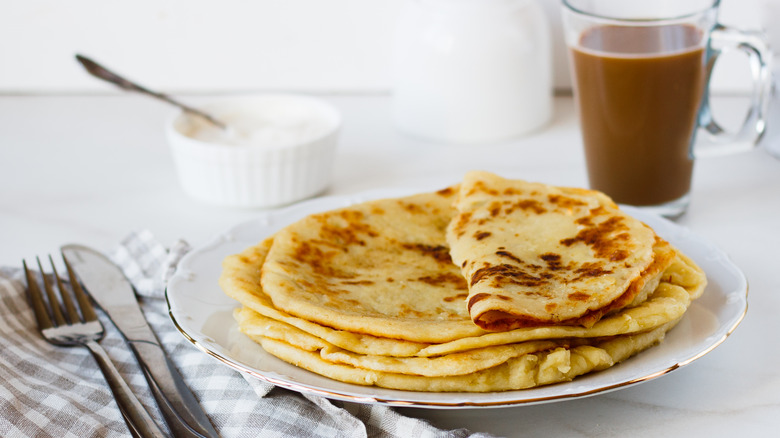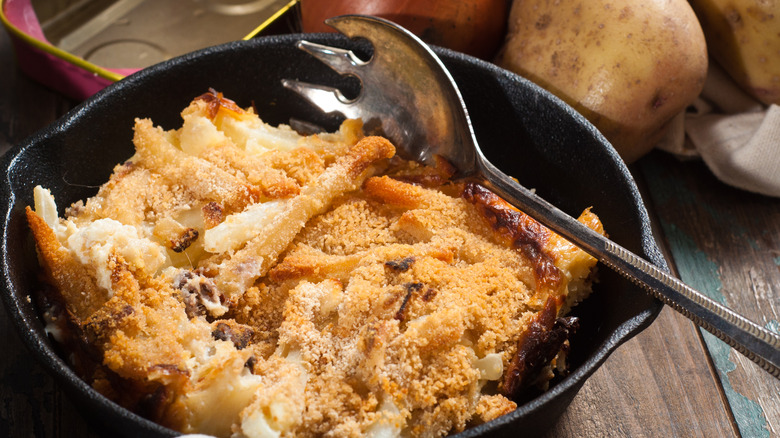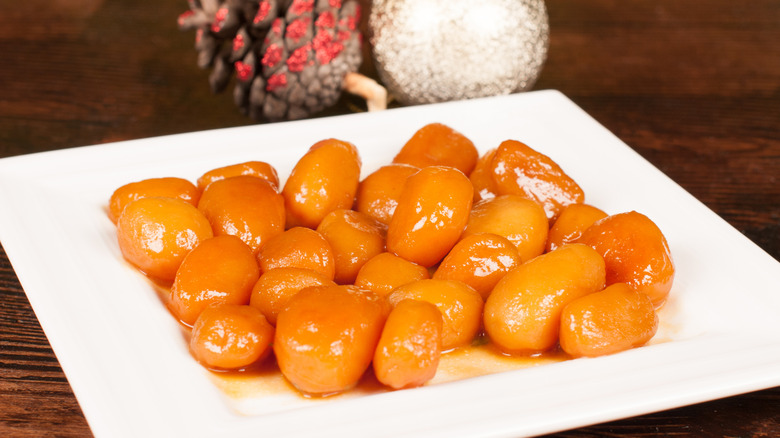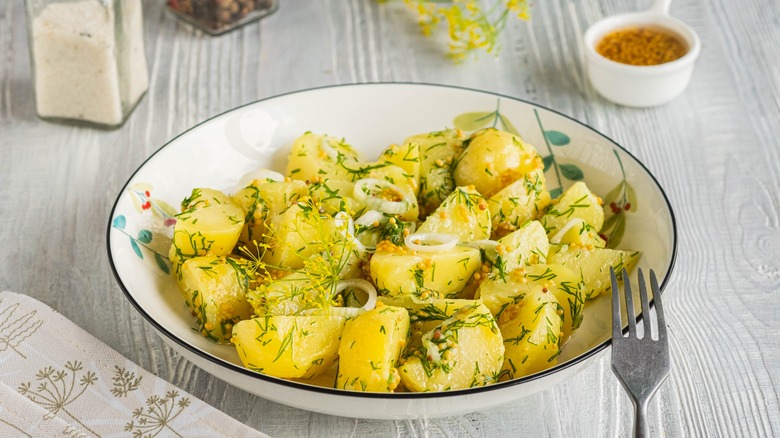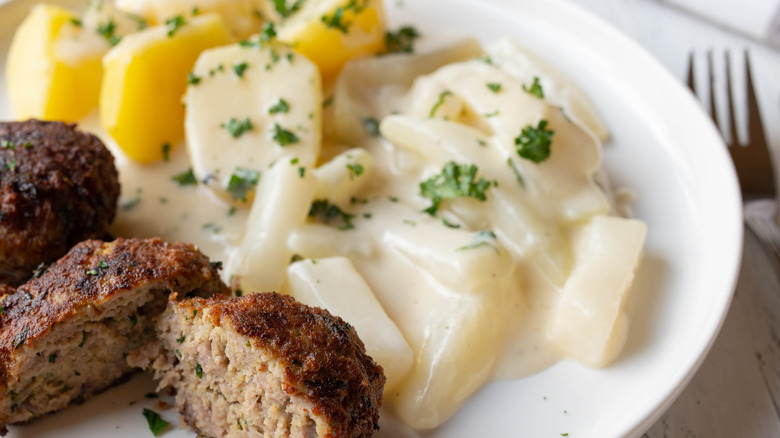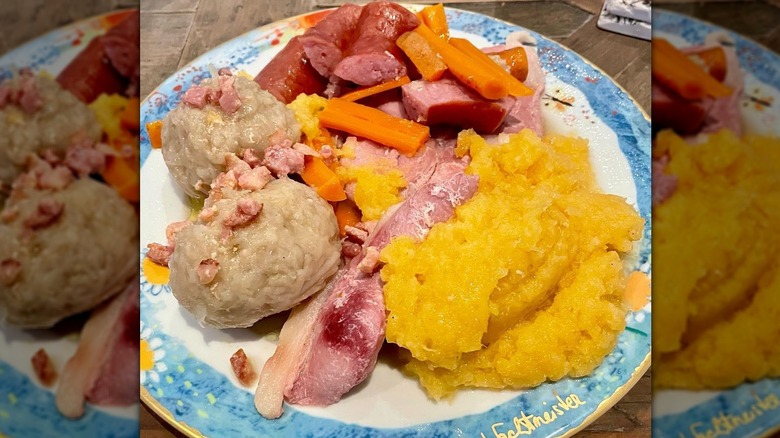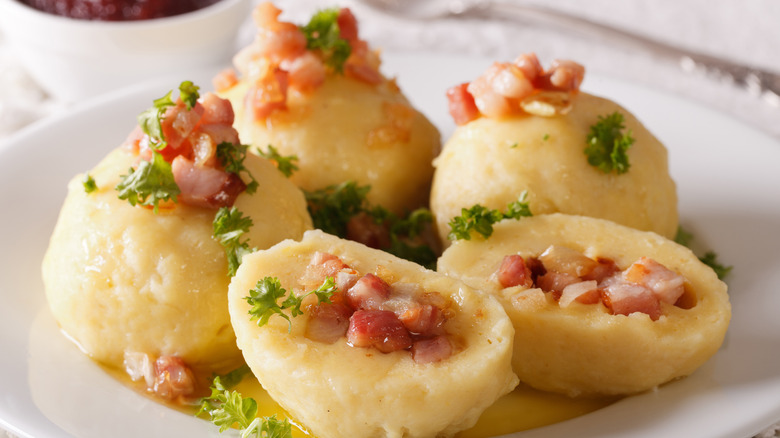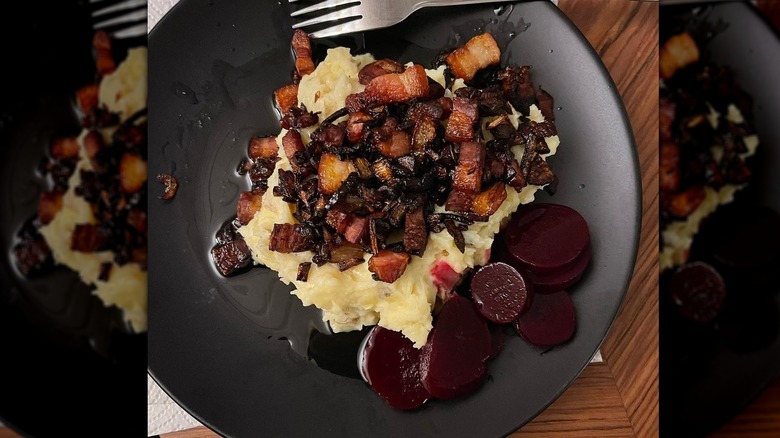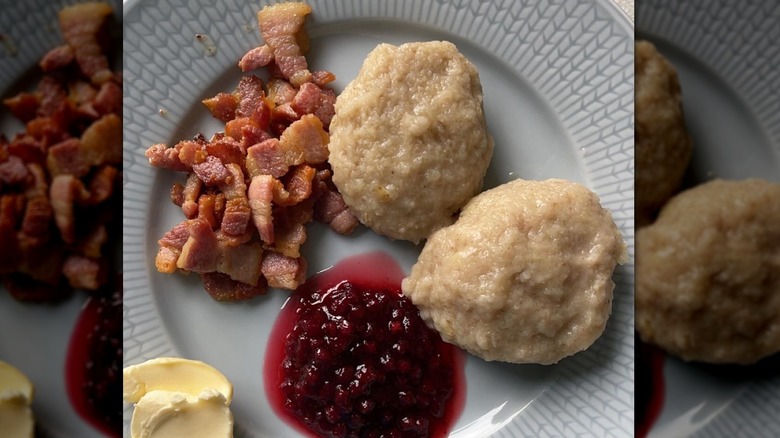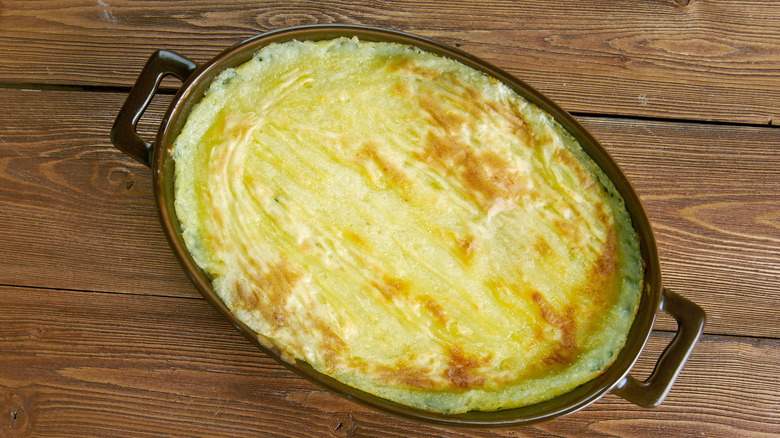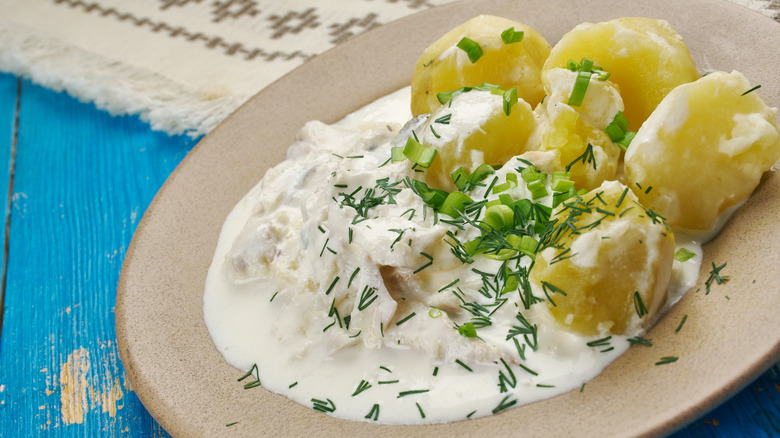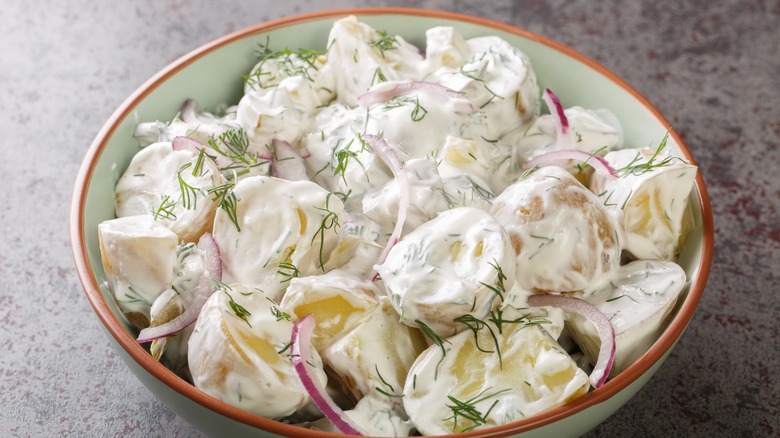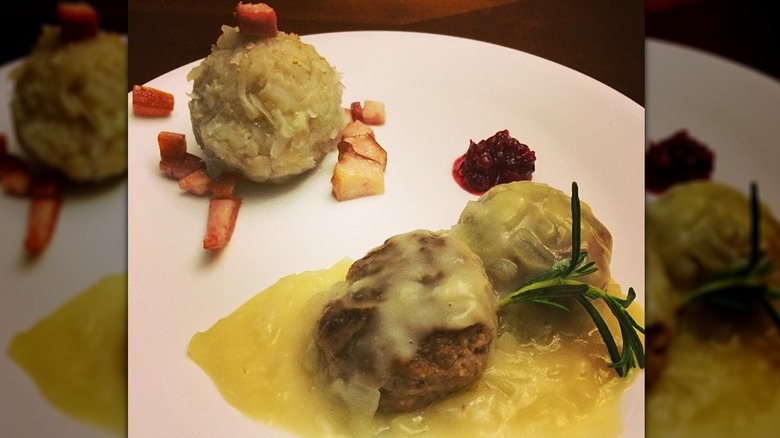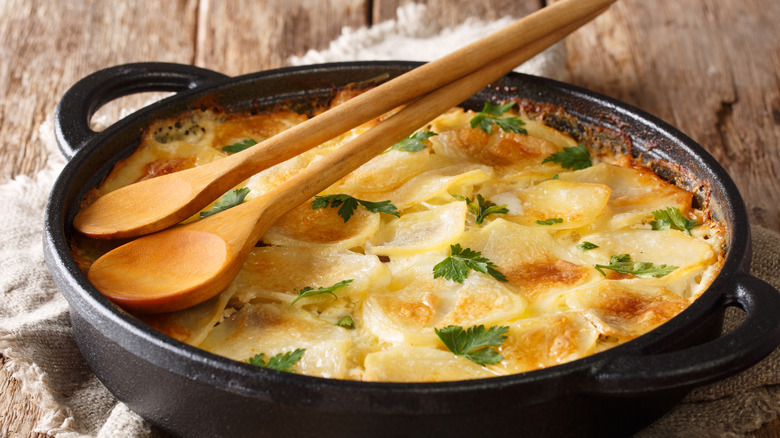16 Scandinavian Potato Dishes You Should Know
When you think of Scandinavian food, what comes to mind? Salmon, Swedish meatballs, and lingonberries are obvious choices. But let's not forget the humble potato. Far from a simple starch, potatoes are both the backbone and soul of many Northern European dishes. Tubers have a hold on this part of the world for many reasons. For starters, they're delicious, filling, and easy to grow in Scandinavia's harsh climate. But more than that, they pair seamlessly with other staples of Nordic cuisine such as fish, cream, apples, and onions.
Given their ubiquity, it makes sense to share some of the top Scandinavian potato dishes you should know. This article provides an in-depth look at spud-based dishes that you'll find in Iceland, Norway, Sweden, Finland, and Denmark. From summery potato salads to hearty potato and fish gratins, you'll discover just how many ways Scandinavians have developed to enjoy their taters.
1. Hasselbackspotatis
Better known by their English name, Hasselback potatoes, this eye-catching Swedish dish will have you looking at potatoes in a whole new light. The name comes courtesy of Hasselbacken, the Stockholm restaurant that invented the recipe in the 1940s. What makes these potatoes so interesting is their shape. Rather than being sliced or cubed, Hasselback potatoes are cut into an accordion shape.
Although the shape looks complex, the preparation is surprisingly easy. All you have to do is slide a skewer into the flat side of the potato, then make thin slices from end to end. The trick is to avoid cutting all the way through. Succeed and you'll be left with one of the most unique potato dishes you've ever seen.
On top of their beauty, Hasselback potatoes are textural perfection. The thinly-sliced edges crisp up in the oven, while the center stays luxuriously tender. They're typically served with sage-infused butter in Sweden, but feel free to add whichever toppings you like. Some of our top picks are bacon bits, hot sauce, cheese, and scallions.
2. Pyttipanna
Pyttipanna (sometimes written as Pytt i Panna) is the Swedish name for what essentially amounts to a potato, meat, and vegetable hash. In fact, the words pytt i panna literally translate to small pieces in a pan. Although we've opted to highlight the Swedish term, it's important to note that this leftover-friendly dish can be found throughout Scandinavia. In Norway, it's known as pyttipanne; in Finland, it's pyttipannu; and in Denmark, it goes by biksemad.
Like a lot of comfort foods, pyttipanna is the product of repurposing ingredients you've already got around the house. For that reason, there are an infinite number of ways to prepare this hearty dish. As long as meat and potatoes are present, you've got everything you need to make a successful pyttipanna. Simply chop up some meat (bacon and ham work particularly well), potatoes, and vegetables, then fry them together. Top the hash with a fried egg and you've got a satisfying meal that's perfect for breakfast, lunch, or dinner.
3. Lefse
As much as we love traditional French crepes, we're always open to trying new variations of this beloved brunch item. That's where lefse comes in. Hailing from Norway, lefse is a flat, potato-based pancake that's slightly thicker than its French cousin. While the exact origins are unclear, many believe that the flatbread originated with the vikings. At that time, it was made from a combination of water, whole wheat flour, and salt. Over time, potatoes replaced much of the flour because they were more easily accessible.
Lefse require quite a bit of work to make, so they're often reserved for the Christmas season. One of the most common ways to serve lefse is by topping them with butter, sugar, and cinnamon. The result is an irresistible snack that pairs perfectly with a steaming mug of hot chocolate. That said, lefse work equally well as an accompaniment to savory ingredients. In particular, Norwegians enjoy buttering lefse and serving it alongside lutefisk (aka baked salt-dried cod).
4. Janssons frestelse
Literally translated, Janssons frestelse means Jannson's temptation. No one knows exactly where the name comes from, but the prevailing theory is that Mr. Janzon was a food-obsessed opera singer. While the exact history is unclear, we do know that the first version of the recipe was published in 1940. It didn't take long for the savory potato dish to become a Yuletime staple in Sweden.
Although the name might sound foreign, Janssons frestelse is basically a gratin. As you might expect from a gratin, it's made with potatoes (russets or Yukon golds), onions, cream, and breadcrumbs. But that's not all. The star ingredient in Janssons frestelse is spice-cured sprats. If you're unfamiliar with sprats, they're small, oily canned fish with a flavor and texture similar to anchovies or sardines.
Unfortunately, it can be hard to find sprats outside of Sweden, so you might have to use anchovies if you're making this dish elsewhere. If you do end up using anchovies, mix a pinch of cinnamon and nutmeg into the cream. These warming spices are pretty similar to the flavors found in the sprat brine, making your version taste as authentic as possible.
5. Brunede kartofler
If you're from North America, you're probably used to adding candied yams to your Thanksgiving or Christmas dinner table. This beloved side dish relies on maple syrup and warming spices like cinnamon, nutmeg, cloves, and ginger to achieve the perfect sweet and savory flavor balance. Scandinavians have a similar dish, however, their version has a base of new potatoes instead of sweet potatoes.
Called brunede kartofler in Denmark and brúnaðar kartöflur in Iceland, these caramelized potatoes are an integral part of Christmas Eve dinner in both countries. The first version of this dish appeared in the Middle Ages, but the original recipe called for chestnuts instead of potatoes. Chestnuts were expensive, so poorer households started substituting potatoes for chestnuts sometime between 1820 and 1850.
Brunede kartofler requires just four simple ingredients: new potatoes, sugar, butter, and water. To prepare the dish, wash, dry, and peel the potatoes. Cook the sugar in a skillet until it melts, then add butter until you obtain a syrup-like consistency. Next, add the potatoes and water and cook everything together for six to eight minutes. Do like the Danes do and serve it as a side dish with either roasted pork belly, goose, or duck.
6. Potatissallad
Pretty much every country around the world welcomes the warm temperatures and slower pace of life that the summer season brings. But no one celebrates summer's arrival more than the Swedes. In Sweden, the summer solstice is a national holiday. Like any good summer holiday, the celebration is full of games, music, and plenty of seasonal food. Some of the most common foods you'll see are pickled herring, gravlax, meatballs, and strawberries.
But no celebration would be complete without potatissallad (aka potato salad). Swedish potato salad combines fresh new potatoes (färskpotatis in Swedish) with mustard sauce, chopped cornichons, capers, and fresh dill. Making this delicious side couldn't be easier. Start by boiling the potatoes until tender. Once cooked and drained, add mustard, cornichons, and capers. Toss until all of the ingredients are evenly distributed. Finish with some salt, pepper, and fresh sprigs of dill. To truly immerse yourself in Swedish culture, make sure to take sips of aquavit in between bites.
7. Kartöflur í jafningi
While you might have heard of some of the more unique dishes Iceland has to offer (fermented shark, anyone?), many of the country's dishes contain just a few simple ingredients. In particular, you're likely to find a combination of fish, lamb, skyr, and potatoes in most dishes. Kartöflur í jafningi, also known as Icelandic potatoes in white sauce, is a good representation of the country's staple ingredients coming together to form a delicious side dish.
Kartöflur í jafningi starts off with peeled boiled potatoes. While the potatoes are cooking, prepare the béchamel-like cream sauce. To make it, melt butter in a saucepan and add flour to create a roux. Next, add some warm milk, whisk, and bring to a boil. Once the sauce thickens up, add salt, white pepper, and nutmeg. Drizzle the sauce over the diced potatoes. For the most traditional presentation, serve it with either lamb or fiskibollur (fried white fish balls).
8. Raspeballer
Pretty much every country has a popular potato dish it claims as its own. Ireland has boxty, South Korea has gamja jorim, and Mexico has empanadas de papa. For its part, Norway has raspeballer. Raspeballer means shredded balls in Norwegian, but these potato dumplings go by a number of different names depending on where in Norway they're made. Komler, komper, or potetballer are just a few of the other terms that refer to these starchy balls.
They're made using a combination of raw and boiled shredded potatoes. The grated potatoes are combined with flour and salt to form a dough, then boiled in either water or broth for 30 to 40 minutes until cooked. Norwegians serve these simple dumplings with a variety of ingredients. Some prefer to go the sweet route, adding syrup, brown sugar, or lingonberry jam. Others serve them as a side dish with pork knuckle, salted lamb, or boiled vegetables. Perhaps the most authentically Norwegian way to serve the dish is with brunost, a brown cheese made from caramelized whey.
9. Kroppkaka
If you've ever eaten a heavy, carb-laden dish before, you've probably experienced the lethargy and sleepiness associated with consuming a large meal. In the medical world, it's known as postprandial somnolence, but the rest of us know it by its common name — a food coma. While you may consider yourself well-versed in food comas, chances are you've never felt the absolute languor that comes after eating the Swedish potato dumplings known as kroppkaka (plural kroppkakor). Heck, the Swedes even refer to the symptoms as a kroppkaka coma.
Kroppkakor originated sometime during the 18th century on the Swedish island of Öland. At that time, the dough was made using a mixture of wheat and barley flours, then stuffed with lamb, goose, or pork. Potatoes replaced barley flour sometime during the mid-19th century. The fillings also evolved over time, with eel and herring making appearances over the course of the dumplings' development.
Nowadays, you're most likely to find kroppkakor filled with fried bacon and onions. While traditional recipes used a fair number of spices, the modern version uses white and black pepper and maybe a bit of allspice. There are two main ways to prepare kroppkakor. The first method involves boiling the stuffed potato balls in water, then covering them with melted butter and lingonberry sauce. If you're a rebel, fry the dumplings in oil, then cover them with béchamel and lingonberry sauce.
10. Brændende kærlighed
With their unfussy flavor, melt-in-your-mouth texture, and endless versatility, we can all agree that mashed potatoes are a wonderful dish. But are they something to feel passionate about? Danes seem to think so. In fact, the Danish call their version of this classic dish brændende kærlighed, something that translates to burning love. The name might seem a bit extreme, but wait until you hear about the ingredients before making a final decision.
Brændende kærlighed starts off with airy mashed potatoes. We recommend using plenty of butter and a hand mixer for the best results. Season to taste with salt, pepper, and nutmeg. For the topping, fry high-quality bacon until crispy. Remove the bacon and cook onions in the bacon fat until translucent. Cut the bacon into small pieces while the onions are cooking. Top the mashed potatoes with the onions and bacon, as well as some fresh herbs like parsley or chives. Serve the dish piping hot alongside syltede rødbeder (aka pickled beets) for the full Danish experience.
11. Palt
The world is full of dumpling recipes, and nowhere is that more true than in Sweden. If you've been paying attention, then you know the Swedes are big fans of kroppkaka (plural kroppkakor), a type of potato dumpling that's stuffed with fried bacon and onion. They're also partial to palt, another type of potato dumpling. At first glance, kroppkakor and palt look quite similar. Indeed, both are made of a potato-based dough stuffed with pork. But that's where the commonalities end.
Whereas kroppkaka dough uses boiled grated potatoes, white flour, eggs, and salt, palt dough is made from raw grated potatoes, wheat flour, and salt. The differences in flour, eggs, and potatoes mean that kroppkakor have a softer texture than palt. Another major difference is that kroppkakor are stuffed with bacon and onions, but palt are filled only with pork. While the differences between the two types of dumplings are significant, they're served in a similar fashion. Some melted butter and lingonberry sauce are all you need to bring these delightful dumplings to life.
12. Imelletty perunalaatikko
The winter holiday season in Finland calls for Advent calendars, outdoor markets, and plenty of hearty food. Baked ham, gingerbread, and beetroot salad are all essentials, but nothing is more important than imelletty perunalaatikko, a slow-cooked, sweetened potato casserole that makes the perfect Christmas side dish.
To make it, boil and mash potatoes. Once the potatoes reach a temperature between 130 and 155 degrees Fahrenheit, add wheat flour and mix until combined. Pay close attention to this step. If you don't let the potatoes cool, the flour and other ingredients won't get absorbed. Put the potato-flour mixture into a Dutch oven and cook in a 140-degree Fahrenheit oven for half an hour. Add more wheat flour and mix. Over the next three to four hours, the potatoes will loosen, become darker in color, and develop a pleasant sweetness. After the timer goes off, add cold milk, melted butter, and salt until you obtain a porridge-like consistency. Transfer to a greased baking dish and cook for three hours at 300 degrees Fahrenheit.
13. Plokkfiskur
If there are two types of food Iceland has an abundance of, it's potatoes and fish. These two dietary staples come together in plokkfiskur, a traditional Icelandic stew that's guaranteed to warm you up, even on the coldest days.
Start with semi-waxy gold or yellow potatoes and white fish such as cod, pollock, or haddock. Cook and mash the potatoes. While they're cooking, boil the fish for five to six minutes. Next, make a béchamel sauce. Once you've got a creamy paste, stir in the fish until it breaks into bite-sized pieces. Then add the mashed potatoes, mixing again until everything is combined. Feel free to add some milk if you prefer a soupier stew, otherwise season with salt and white pepper before digging in. You can also get creative with your mix-ins. Bacon, curry powder, sugar, and nutmeg are all excellent additions to plokkfiskur. You tcan even add some cheddar, gouda, or mozzarella cheese on top. Pair your stew with a sturdy slice of rye bread slathered with butter.
14. Färskpotatissallad
Not to be confused with classic potato salad (potatissallad), färskpotatissallad (aka fresh potato salad) is yet another summery spud dish to come out of Sweden. Whereas standard Swedish potato salad calls for mustard sauce, capers, and cornichons, färskpotatissallad is made with new potatoes, sour cream or crème fraîche, chopped fresh dill, and mayonnaise.
If you've ever made potato salad before, the preparation will be familiar. Begin by peeling and boiling the potatoes. Once cooked, cut them into small cubes and allow them to cool. In a separate bowl, combine with crème fraîche or sour cream, mayonnaise, and fresh sprigs of dill. Finally, fold the potato chunks into the liquid mixture. Chill for at least one hour before serving. The Swedish typically consume this dish during Midsummer's Eve picnics. There, it's served as part of a smorgäsbord buffet alongside gravlax, smoked salmon, pickled herring, crisp bread, and fresh strawberry cake.
15. Potato klubb
Eastern European dumplings have a way of stealing the show. After all, this part of the world counts pierogis, pelmenis, and khinkali among its top culinary exports. But just because Eastern Europe has a lot of dumplings to offer, doesn't mean that you won't find equally delicious varieties elsewhere on the continent. Take Norway's potato klubb as an example. While these simple, potato-based dumplings probably won't win any innovation awards, they're a delicious way to experiment with Norwegian cuisine.
Potato klubb dough is made out of flour, salt, baking powder, black pepper, and grated raw potatoes. Once you've got a stiff, bread-like dough, begin forming the dumplings. To make a dumping, tear off a piece of dough and wrap it around a chunk of ham. Drop the dumplings into a pot of boiling water and cook for approximately 45 minutes. Keep a close eye on the pot as the dumplings are cooking to ensure that none stick to the bottom. When the timer dings, use a slotted spoon to remove the dumplings. Serve with butter, salt, pepper, and scallions.
16. Janssonin kiusaus
One of the best things about potatoes is that they don't require a lot of fancy add-ons to taste good. Case in point: janssonin kiusaus, a four-ingredient Finnish potato casserole similar to scalloped potatoes. Besides potatoes, you'll need an onion, anchovy fillets, and some cream.
To make it, peel and slice the potatoes. You can even julienne them if you feel up to it. Next, halve the onion and chop it into thin slices. Make layers in a large baking dish, starting with a layer of potatoes, followed by a layer of onions, and a layer of anchovies. Continue layering until you've used up all of the ingredients. Bake in a 400-degree Fahrenheit oven for about an hour (or until the potatoes brown). The Finnish typically eat this hearty dish at Christmas alongside pickled beets and gherkins, but any cold winter day is the right time to dig in.
Static Media owns and operates Tasting Table and Mashed.
